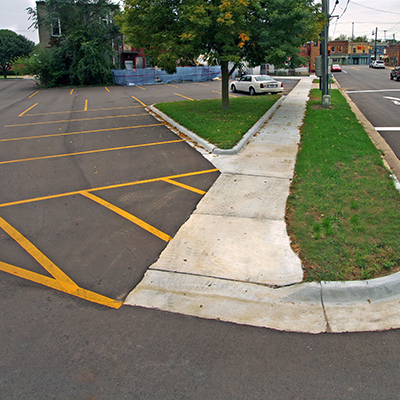By Kimberly Jongsma, Public Outreach and Planning Specialist
Finding a place to park is often an issue in downtowns, especially during events. The first solution most people think of is to add more spaces and lots, but making convenient “free” parking a sole priority can decrease a downtown’s vibrancy. There is such a thing as too much parking (think of Kmart lots). Downtowns are for people, not cars, so keep it on a pedestrian scale. Regulation and communication can keep parking demands in balance. (For a much smaller cost!)
Downtown Parking Policy
Time Limits and High Turnover
Does your “main street” have on-street parking with no time limit? If so, you are encouraging longer stays and discouraging quick errands, or “high turnover.” For those just dropping in for their 15-minute errand or one-hour lunch, not being able to find parking may deter them from going downtown at all. Parking time limits (anywhere from 15 minutes to two hours) encourage higher turnover, which means more people circulating through the downtown businesses. If someone intends to visit your downtown for a long stay, parking off-street or farther away won’t bother them too much. Many people don’t mind walking a block or two, though handicap and other designated spaces are a must for those who need easier access.
This kind of smart regulation can also include reserved spaces for residents and employees of your downtown. Their main concern is having a reliable space within a reasonable distance of their home or work. That’s something you can work with—they’re guaranteed a spot for when they need it (even if it’s off-street).
Update your parking policy so everyone can be happy. It is possible! Here are some on-street parking categories:
- Handicap designation with ADA accessibility (obviously a must)
- 15-30 minute multi-use spaces
- 30-minute parking
- Two-hour or four-hour parking
- Expectant Mothers / Small Children Priority Spaces
- Senior Citizen Priority Spaces
- Motorcycle spaces
- Convenient bicycle parking
- Restricted hours (No overnight parking, only between 8am-6pm, etc.)
- Permit spaces (for residents, employees, etc)
- Reserved spaces (for residents, employees, etc)
Signs and pavement symbols make people aware of these policies; local enforcement is the other half of making this work. Parking tickets don’t have to be very expensive to get the message across.
Just a Communication Issue?
Sometimes a parking problem is really a communication problem in disguise. Maybe there is enough parking, but not enough awareness: do the residents know where they can park downtown? Are time limits and costs clear? Are designated spaces marked and labeled? Uncertainty can cause stress and confusion for visitors. Have plenty of signs saying where parking is allowed, and for how long. A downtown parking map is very helpful for residents and visitors: an easy-to-read map showing what types of parking are available. Make it available online so they can use it in planning their trip. When hosting community events, put instructions and visuals in the flyers/invitations for where to park, or other ways people can get downtown.
Conclusion
Plan parking with your community. Come to an agreement on a set of rules that puts pedestrians first, but makes parking and wayfinding easy. This way, everyone wins.
Have a specific question? Our traffic engineer, planner, landscape architect, and streetscape engineers are ready to help! Call us: 616-364-8491.

